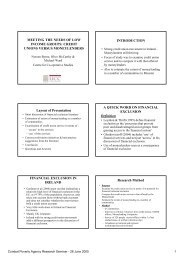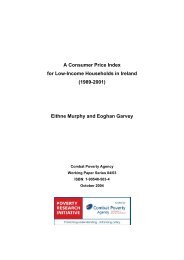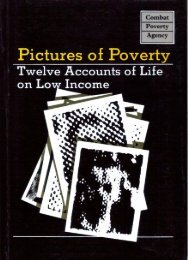The Distribution of Income in Ireland (2000) - Combat Poverty Agency
The Distribution of Income in Ireland (2000) - Combat Poverty Agency
The Distribution of Income in Ireland (2000) - Combat Poverty Agency
- No tags were found...
Create successful ePaper yourself
Turn your PDF publications into a flip-book with our unique Google optimized e-Paper software.
46 <strong>The</strong> <strong>Distribution</strong> <strong>of</strong> <strong>Income</strong> <strong>in</strong> <strong>Ireland</strong>Table 4.6: Suits Progressivity Index and Average Tax Ratefor <strong>Income</strong> Tax and PRSI Contributions, 1973, 1980, 1987and 1994/95Average Tax Rate (%)<strong>Income</strong> taxPRSI contributionsTotalSuits Progressivity Index<strong>Income</strong> taxPRSI contributionsTotal1973 1980 1987 1994/957.82.09.80.194-0.0740.13812.92.215.10.2070.0560.18515.43.518.90.2750.1330.24914.23.717.80.2820.1470.254Source: Figures for 1973 from Nolan (1981), for 1980, 1987 and 1994-95 calculatedfrom HBS Reports.Focus<strong>in</strong>g on the degree <strong>of</strong> progressivity, Nolan (1981) used theSuits progressivity <strong>in</strong>dex to show that <strong>in</strong> 1973 <strong>in</strong>come tax wasprogressive but social security contributions were mildly regressive(as <strong>in</strong>dicated by the negative value <strong>of</strong> the <strong>in</strong>dex). 12From Table 4.6 we see that by 1980 <strong>in</strong>come tax was slightlymore progressive but social <strong>in</strong>surance contributions were nowalso progressive. 13 Between 1980 and 1987, <strong>in</strong>come tax becamea good deal more progressive and so did social <strong>in</strong>surance contributions.However, contributions became a more importantelement <strong>in</strong> the total over this period and rema<strong>in</strong>ed a good dealless progressive than <strong>in</strong>come tax. <strong>The</strong> net result was that theSuits <strong>in</strong>dex for <strong>in</strong>come tax plus social <strong>in</strong>surance contributionstogether rose by almost as much between 1973-1980 as between1980-1987, register<strong>in</strong>g an <strong>in</strong>crease <strong>of</strong> 34 per cent <strong>in</strong> theearner period and 35 per cent <strong>in</strong> the later one. Between 1987Trends <strong>in</strong> <strong>Income</strong> <strong>Distribution</strong> s<strong>in</strong>ce 1973 47and 1994, the Suits <strong>in</strong>dex rose marg<strong>in</strong>ally for both <strong>in</strong>come taxand social <strong>in</strong>surance contributions, but they both now decl<strong>in</strong>edas a proportion <strong>of</strong> gross <strong>in</strong>come.We can analyse <strong>in</strong> more depth the way the <strong>in</strong>come distributionevolved between 1987 and 1994, by exploit<strong>in</strong>g the fact thatmicrodata is available for those years. We do this by carry<strong>in</strong>gout for 1987 the same sub-group decomposition analysis thatwe presented for 1994 and 1997 <strong>in</strong> Chapter 3, us<strong>in</strong>g the meanlog deviation <strong>in</strong>equality measure. Decomposition by labourforce status was the one to reveal the most substantial changesbetween 1994 and 1997, and this also turned out to be the casefor 1987-1994 so we concentrate on those results here. Table4.7 shows that <strong>in</strong> 1987 <strong>in</strong>equality between the groups accountedfor 13 per cent <strong>of</strong> overall <strong>in</strong>equality, whereas by 1994 this hadrisen to 27 per cent. This reflects the fact that there was lessvariation <strong>in</strong> mean <strong>in</strong>comes across the groups <strong>in</strong> 1987, as well asthe higher <strong>in</strong>equality with<strong>in</strong> certa<strong>in</strong> groups — notably the selfemployed,the unemployed or ill, and households headed bysomeone work<strong>in</strong>g full-time <strong>in</strong> the home — <strong>in</strong> that year. Thus by1994 <strong>in</strong>equality with<strong>in</strong> these groups had decl<strong>in</strong>ed while thedifferences between the groups <strong>in</strong> mean <strong>in</strong>comes had widened,with households headed by someone who was unemployed orill, or work<strong>in</strong>g full-time <strong>in</strong> the home, fall<strong>in</strong>g further beh<strong>in</strong>d theaverage.12 <strong>The</strong> <strong>in</strong>dex is calculated on the basis <strong>of</strong> share <strong>of</strong> tax paid by gross <strong>in</strong>comegroups and the share <strong>of</strong> gross <strong>in</strong>come they receive.Murphy (1984) presents the Suits (and Kakwani) progressivity <strong>in</strong>dex calculatedfor equivalent (market) <strong>in</strong>come for 1973 and 1980. Like Table 4.6 (basedon unadjusted gross <strong>in</strong>come), this showed the degree <strong>of</strong> progressivity <strong>of</strong> <strong>in</strong>-" ^ ^Sfed * that <strong>of</strong> employees' social security contributionssignificantly <strong>in</strong>creased between 1973 and 1980.
















